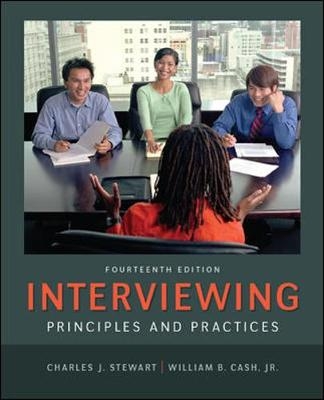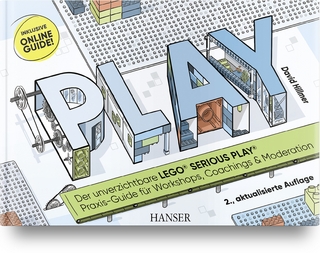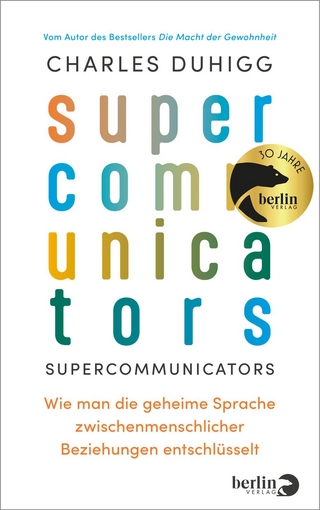
Interviewing: Principles and Practices
McGraw-Hill Professional (Verlag)
978-0-07-803694-1 (ISBN)
- Titel erscheint in neuer Auflage
- Artikel merken
Interviewing: Principles and Practices, the most widely used text for the interviewing course, continues to reflect the growing sophistication with which interviewing is being approached, incorporating the ever-expanding body of research in all types of interview settings, recent communication theory, and the importance of equal opportunity laws on interviewing practices. It provides the most thorough treatment of the basics of interviewing, including the complex interpersonal communication process, types and uses of questions, and the structuring of interviews from opening to closing.
Instructors and students can now access their course content through the Connect digital learning platform by purchasing either standalone Connect access or a bundle of print and Connect access. McGraw-Hill Connect® is a subscription-based learning service accessible online through your personal computer or tablet. Choose this option if your instructor will require Connect to be used in the course. Your subscription to Connect includes the following:
• SmartBook® - an adaptive digital version of the course textbook that personalizes your reading experience based on how well you are learning the content.
• Access to your instructor’s homework assignments, quizzes, syllabus, notes, reminders, and other important files for the course.
• Progress dashboards that quickly show how you are performing on your assignments and tips for improvement.
• The option to purchase (for a small fee) a print version of the book. This binder-ready, loose-leaf version includes free shipping.
Complete system requirements to use Connect can be found here: http://www.mheducation.com/highered/platforms/connect/training-support-students.html
Charles J. Stewart is the former Margaret Church Distinguished Professor of Communication at Purdue University where he taught from 1961 to 2009. He taught undergraduate courses in interviewing and persuasion and graduate courses in such areas as persuasion and social movements, apologetic rhetoric, and extremist rhetoric on the Internet. He received the Charles B. Murphy Award for Outstanding Undergraduate Teaching from Purdue University and the Donald H. Ecroyd Award for outstanding Teaching in Higher Education from the National Communication Association. He has written articles, chapters, and books on interviewing, persuasion, and social movements. He has been a consultant with organizations such as the Internal Revenue Service, the American Electric Power Company, Libby Foods, the Indiana University School of Dentistry, and the United Association of Plumbers and Pipefitters. He is currently a Court Appointed Special Advocate for children (CASA). William B. Cash received his Ph.D. from Purdue University in 1972. He is currently an Associate Professor of Communication at National-Louis University in Evanston, Illinois.
Chapter 1 An Introduction to InterviewingThe Essential Elements of InterviewsPartiesPurposeInteractional QuestionsExercise #1—What Is and Is Not an Interview?Traditional Forms of InterviewingInformation-Giving InterviewsInformation-Gathering InterviewsFocus Group Interviews Selection InterviewsPerformance ReviewsCounseling InterviewsPersuasion InterviewsTechnology and InterviewingThe Focus Group InterviewThe Telephone InterviewThe Videoconference InterviewThe E-Mail InterviewThe Virtual InterviewWebinarsSUMMARYKEY TERMS AND CONCEPTSAN INTERVIEW FOR REVIEW AND ANALYSISSTUDENT ACTIVITIESNOTESRESOURCESChapter 2 An Interpersonal Communication ProcessTwo Parties in the InterviewRelational Dimensions Global Relationships Gender in Relationships Interchanging Roles during Interviews Directive ApproachNondirective ApproachCombination of ApproachesPerceptions of Interviewer and IntervieweePerceptions of SelfPerceptions of the Other PartyCommunication InteractionsLevels of Interactions Gender, Culture, and Self-DisclosureVerbal InteractionsNonverbal InteractionsFeedbackListening for ComprehensionListening for EmpathyListening for EvaluationListening for ResolutionThe Interview SituationInitiating the InterviewPerceptionsTime of Day, Week, and YearPlaceSurroundingsTerritorialityOutside ForcesSUMMARY KEY TERMS AND CONCEPTS AN INTERVIEW FOR REVIEW AND ANALYSIS STUDENT ACTIVITIES NOTES RESOURCESChapter 3 Questions and Their UsesOpen and Closed QuestionsOpen QuestionsClosed QuestionsPrimary and Probing QuestionsTypes of Probing QuestionsSkillful Interviewing with Probing QuestionsExercise #1—Supply the Probing QuestionNeutral and Leading QuestionsLoaded QuestionsExercise #2—Identification of QuestionsCommon Question PitfallsThe Bipolar TrapThe Tell Me EverythingThe Open-to-Closed SwitchThe Double-Barreled InquisitionThe Leading PushThe Guessing GameThe Yes (No) ResponseThe Curious ProbeThe Quiz ShowComplexity vs. SimplicityThe Don’t Ask, Don’t TellExercise #3—What Are the Pitfalls in These Questions?SUMMARYKEY TERMS AND CONCEPTS AN INTERVIEW FOR REVIEW AND ANALYSIS STUDENT ACTIVITIESNOTESRESOURCESChapter 4 Structuring the InterviewThe Body of the InterviewInterview GuideInterview SchedulesExercise #1—Interview SchedulesvQuestion SequencesOpening the InterviewvThe Two-Step ProcessVerbal Opening TechniquesvNonverbal Communication in OpeningsExercise #2—Interview OpeningsClosing the InterviewGuidelines for Closing InterviewsClosing TechniquesExercise #3—Interview ClosingsSUMMARY KEY TERMS AND CONCEPTS AN INTERVIEW FOR REVIEW AND ANALYSIS STUDENT ACTIVITIES NOTESRESOURCESChapter 5 The Informational Interview Preparing the InterviewDetermine Your PurposeResearch the TopicStudy the situation Structure the InterviewSelecting Interviewees and InterviewersSelecting IntervieweesSelecting InterviewersRelationship of Interviewer and IntervieweeChoose the Location and SettingOpening the InterviewConducting the InterviewMotivating IntervieweesAsking QuestionsPhrasing Questions Note Taking and RecordingHandling Difficult SituationsHandling Difficult IntervieweesClosing the InterviewPreparing the Report or StoryThe Interviewee in the Probing InterviewDo Your HomeworkUnderstand the RelationshipBe Aware of the SituationAnticipate QuestionsListen to QuestionsAnswer StrategicallySUMMARYKEY TERMS AND CONCEPTSA PROBING INTERVIEW FOR REVIEW AND ANALYSISPROBING ROLE -PLAYING CASESSTUDENT ACTIVITIESNOTESRESOURCESChapter 6 The Survey InterviewPurpose and ResearchStructuring the InterviewInterview Guide and ScheduleThe OpeningThe ClosingSurvey QuestionsPhrasing QuestionsSample Question DevelopmentProbing QuestionsQuestion StrategiesQuestion ScalesQuestion SequencesSelecting IntervieweesDefining the PopulationSampling TechniquesSelecting and Training InterviewersNumber NeededQualificationsPersonal CharacteristicsTraining InterviewersConducting Survey InterviewsPretesting the InterviewInterviewing Face-to-FaceInterviewing by TelephoneInterviewing through the InternetCoding, Tabulation, and AnalysisCoding and TabulationAnalysisThe Respondent in Survey InterviewsThe OpeningThe Question Phase SUMMARYKEY TERMS AND CONCEPTS A SURVEY INTERVIEW FOR REVIEW AND ANALYSIS SURVEY ROLE -PLAYING CASESChapter 7 The Recruiting InterviewWhere to Find Good ApplicantsPreparing the Recruiting EffortReviewing EEO LawsExercise #1—Testing Your Knowledge of EEO LawsDeveloping an Applicant ProfileAssessing What Applicants WantObtaining and Reviewing Information on ApplicantsApplication Forms Resumes Cover Letters Letters of Recommendation and ReferencesStandardized TestsSocial MediaConduct the InterviewThe Atmosphere and SettingThe Interview PartiesOpening the InterviewThe Body of the InterviewClosing the InterviewAsking QuestionsCommon Question PitfallsTraditional QuestionsNontraditional Questions Closing Thoughts on Use of QuestionsGiving InformationEvaluating the InterviewSUMMARYKEY TERMS AND CONCEPTSA RECRUITING INTERVIEW FOR REVIEW AND ANALYSIS RECRUITING ROLE -PLAYING CASESSTUDENT ACTIVITIESNOTESRESOURCESChapter 8 The Employment InterviewAnalyze YourselfQuestions to Guide Your Self-AnalysisDo Your Homework Research Your Field Research the Organizations Research the RecruiterResearch the PositionResearch Current EventsResearch the Interview ProcessConduct the SearchNetworkingSocial MediaWeb Sites, Classified Ads, and NewslettersCareer Centers and Employment AgenciesThe Career/Job FairKnocking on DoorsPresenting Yourself to the EmployerBrandingResumesThe PortfolioThe Cover LetterCreating a Favorable First ImpressionRelationship of the Interview PartiesNonverbal CommunicationInterview EtiquetteAnswering QuestionsPreparing to RespondStructuring Answers Respond SuccessfullyRespond UnsuccessfullyResponding to Unlawful QuestionsExercise #1—Which Questions Are Unlawful and Why?Asking QuestionsGuidelines for Asking QuestionsQuestion PitfallsExercise #2—Applicant PitfallsSample Applicant QuestionsThe ClosingEvaluation and Follow-UpHandling RejectionSUMMARYKEY TERMS AND CONCEPTSAN EMPLOYMENT INTERVIEW FOR REVIEW AND ANALYSISEMPLOYMENT ROLE-PLAYING CASESSTUDENT ACTIVITIESNOTESRESOURCESChapter 9 Approaching the Interview as a Coaching OpportunityPreparing for the Performance InterviewReviewing Rules, Laws, and RegulationsSelecting a Review ModelBehaviorally Anchored Rating Scales (BARS) ModelManagement by Objectives (MBO) ModelUniversal Performance Interviewing ModelThe 360-Degree ApproachConducting the Performance InterviewOpening the InterviewDiscussing PerformanceSetting New Goals and a Plan of ActionClosing the InterviewThe Employee in the Performance ReviewThe Performance Problem InterviewDetermine Just CausePrepare for the InterviewKeep Self and the Situation under ControlFocus on the ProblemAvoid Conclusions during the InterviewClosing the InterviewSUMMARYKEY TERMS AND CONCEPTSA PERFORMANCE INTERVIEW FOR REVIEW AND ANALYSISPERFORMANCE REVIEW ROLE -PLAYING CASESSTUDENT ACTIVITIES NOTES RESOURCESChapter 10 The Persuasive InterviewThe Ethics of PersuasionWhat Is Ethical?Fundamental Ethical GuidelinesPart I: The Interviewer in the Persuasive InterviewAnalyzing the IntervieweePersonal CharacteristicsEducation, Social, and Economic BackgroundsCulture Values/Beliefs/AttitudesEmotionsAnalyzing the SituationAtmosphereTimingPhysical SettingOutside ForcesResearching the IssueSourcesTypes of EvidencePlanning the InterviewDetermine Your PurposeSelect Main PointsDevelop Main PointsSelect StrategiesConducting the InterviewOpeningNeed or Desire Questions Adapting to the IntervieweeThe SolutionConsidering the SolutionHandling ObjectionsClosingSummary OutlinePart 2: The Interviewee in the Persuasive InterviewBe an Informed ParticipantPsychological StrategiesLanguage StrategiesLogical StrategiesEvidenceBe an Active ParticipantThe OpeningNeed or DesireCriteriaSolutionThe ClosingSUMMARYKEY TERMS AND CONCEPTSA PERSUASIVE INTERVIEW FOR REVIEW AND ANALYSISPERSUASION ROLE -PLAYING CASESSTUDENT ACTIVITIESNOTES RESOURCESChapter 12 The Counseling InterviewEthics and the Counseling InterviewEstablish and Maintain TrustAct in the Interviewee's Best InterestsUnderstand Your LimitationsDo Not Impose Your Beliefs, Attitudes, and ValuesRespect DiversityMaintain Relational BoundariesDo No HarmPrepare Thoroughly for the Counseling InterviewAnticipate Questions and ResponsesConsider Interviewing ApproachesSelect a StatureSelect the SettingConducting the InterviewThe OpeningEncourage Self-DisclosureListenObserveQuestionRespondThe ClosingEvaluate the InterviewThe Telepho
ne InterviewSUMMARYKEY TERMS AND CONCEPTSA COUNSELING INTERVIEW FOR REVIEW AND ANALYSISCOUNSELING ROLE -PLAYING CASESSTUDENT ACTIVITIESNOTESRESOURCESChapter 13 The Health Care InterviewEthics and the Health Care InterviewPatient-Centered Care (PCC)Sharing ControlAppreciating DiversityCreating and Maintaining TrustOpening the InterviewEnhancing the ClimateEstablishing RapportGetting InformationBarriers to Getting InformationWays to Improve Information GettingAddressing the Language BarrierGiving InformationCauses for Loss and Distortion of InformationGiving Information More EffectivelyCounseling and PersuadingBarriers to Effective Counseling and PersuadingEffective Counseling and PersuadingClosing the InterviewSUMMARYKEY TERMS AND CONCEPTS A HEALTH CARE INTERVIEW FOR REVIEW AND ANALYSISHEALTH CARE ROLE -PLAYING CASESSTUDENT ACTIVITIESNOTES RESOURCESGlossaryAuthor IndexSubject Index
| Erscheint lt. Verlag | 16.10.2013 |
|---|---|
| Zusatzinfo | 22 Illustrations, unspecified |
| Sprache | englisch |
| Maße | 218 x 231 mm |
| Gewicht | 646 g |
| Themenwelt | Sachbuch/Ratgeber ► Beruf / Finanzen / Recht / Wirtschaft ► Briefe / Präsentation / Rhetorik |
| Sozialwissenschaften ► Pädagogik ► Sozialpädagogik | |
| Sozialwissenschaften ► Soziologie | |
| Wirtschaft ► Betriebswirtschaft / Management ► Personalwesen | |
| ISBN-10 | 0-07-803694-1 / 0078036941 |
| ISBN-13 | 978-0-07-803694-1 / 9780078036941 |
| Zustand | Neuware |
| Haben Sie eine Frage zum Produkt? |
aus dem Bereich



